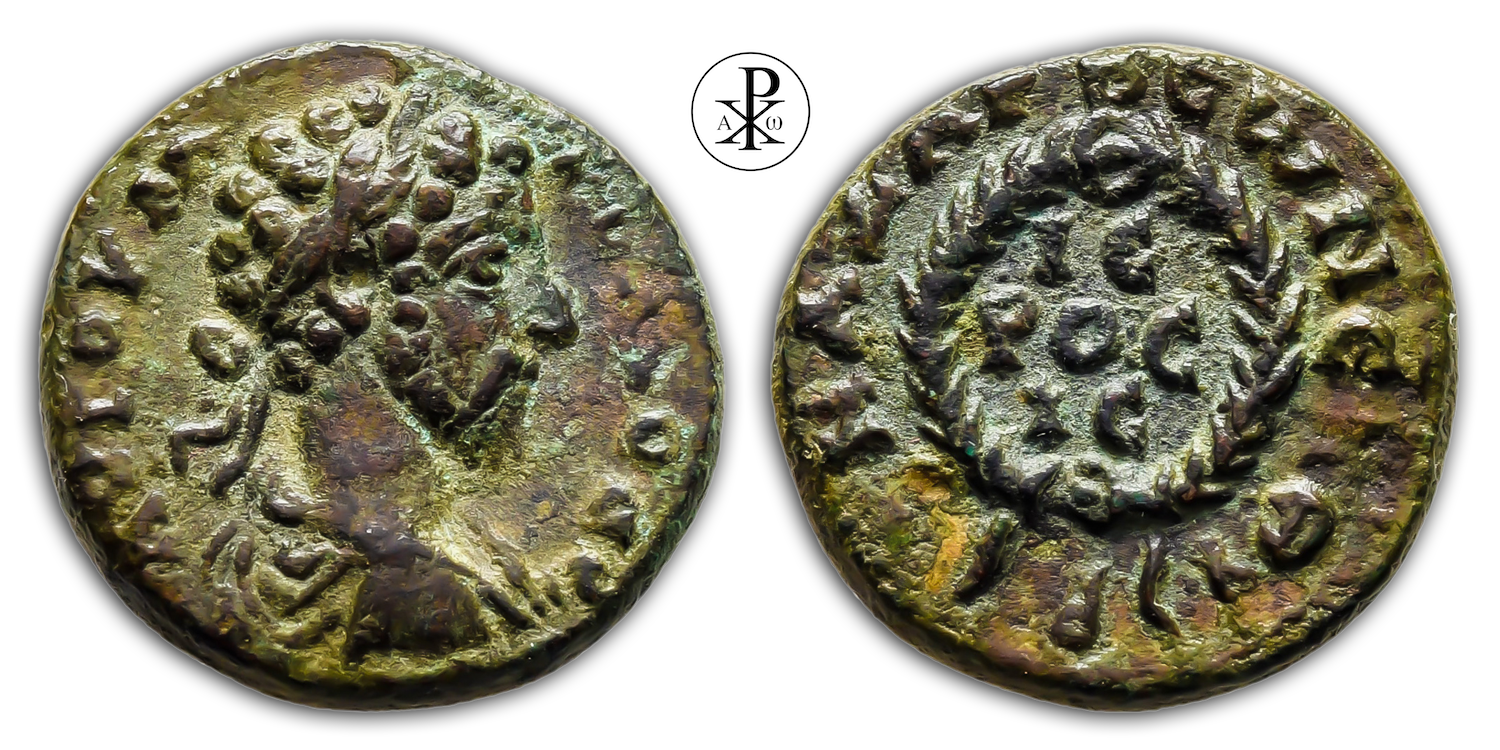Imperator Caesar Marcus Aurelius Commodus Antoninus Augustus
Reign: Commodus
Mint: Anazarbus, Cilicia
Date: 180/181 AD
Nominal: Bronze
Material: AE
Diameter: 21mm
Weight: 7.10g
Reference: RPC IV.3 3653 (#44 this coin)
Reference: Ziegler, Anazarbos 210–12 and 214–22
RPC Online: https://rpc.ashmus.ox.ac.uk/coins/4/3653
Rare: Specimens 44 (7 in the core collections)
Provenance: Savoca Numismatik Munich, Germany (Auction 161, Lot 286)
Pedigree: –
Obverse: Laureate-headed bust of Commodus (short beard) wearing cuirass and paludamentum, right
Inscription: ΑVΤΟ K Μ ΑV ΚΟΜΟΔΟC
Translation: Autokrator Kaisaros Marcos Aurelios Komodos
Translation: Imperator Caesar Marcus Aurelius Commodus
Reverse: Wreath
Inscription: ΙƐΡΟϹ ΙϹ(Ɛ) [in three lines in wreath] ΑΝΑΖΑΡΒƐⲰΝ ƐΤ ΘϞΡ
Translation: Ieros Iselastikos, Anazarbeoun, Etoyc Theta (9) Qoppa (90) Rho (100)
Translation: Sacred iselactic games, City of Anazarbus, Year 199 [Dated according to the Pompeian-Cilician era] = 180/181 AD
Comment: Anazarbus, is an ancient city in northeastern Cilicia (now in Adana province, Turkey). Other name forms are: Anazarbos, Anarzabus, Anazarba, Latin Caesarea ad Anazarbum or also Justinianopolis. The name is derived from a legendary founder of the same name or from a mountain nearby, the “Anavarza Rock”. Anazarbus is located 28 km south of Kozan (Sis) in the province of Adana on the river Ceyhan (ancient Pyramos). Due to its more than 200 m high castle mountain, a foothill of the Taurus, which juts into the Cilician plain, the fortification there had great strategic importance throughout antiquity. According to the first excavation results, the castle mountain was already inhabited in prehistoric times. The city has been documented by coinage since the 2nd century BC. In 67 BC the former pirate Tarkondimotos I was appointed king of Anazarbus by Pompeius. He died in the naval battle of Actium, where he fought on the side of Marcus Antonius. Under his successor Tarkondimotos II, the city was renamed “Kaisareia at Anazarbos” in honor of Augustus and the city began a new era. After the death of King Tarkondimotos II, Rome assumed direct rule. The settlement received city rights from Augustus in 19 BC and was incorporated into the Roman Empire shortly thereafter. Cilicia – and Anazarbus as part of it – was united with Cilicia Tracheia by Vespasian in AD 72. This Cilician province was then in turn united with Isauria and Lycaonia to form the “three eparchies” in the time of Hadrian or Antoninus Pius. In 260 AD, Anazarbus was conquered by the Sassanid king Shapur I. Around 380 AD the city was devastated by the Isaurian bandit Balbinus. Under Theodosius II, Anazarbus became the capital of the province of Cilicia Secunda.
Note on the reverse inscription “ΙƐΡΟϹ ΙϹ” in the pictured wreath: Ziegler, Kaiser, Herr und städtisches Geld (also known as Ziegler, Anazarbus), pg. 110, states that it means IEROS ISELASTIKOS and thus takes reference to the iselactic games, the Hadriania Olympia, occurring in Anazarbus. Iselastic means that victors had the privilege of a triumphal entry into their home cities. Anazarbus was obviously proud of its right to have such high-level, iselastic games [1]. The Hadrianeia or Hadriana Olympia of Anazarbus were founded to commemorate one of the two visits of the Emperor Hadrian, either 117-118 AD or 131 AD. In some cases, cities held agons in honor of the emperor, not just on a one-time occasion, but on a regular basis. In the cities that the emperor not only visited, but also granted titles or favors, permanent agons were established, which are proven to have been held until the third century AD, such as in Heracleia, Antioch, Tarsus, Cyzicus – or just in Anazarbus.
[1] Thanks for the information from the user Thilo at forumancientcoins
